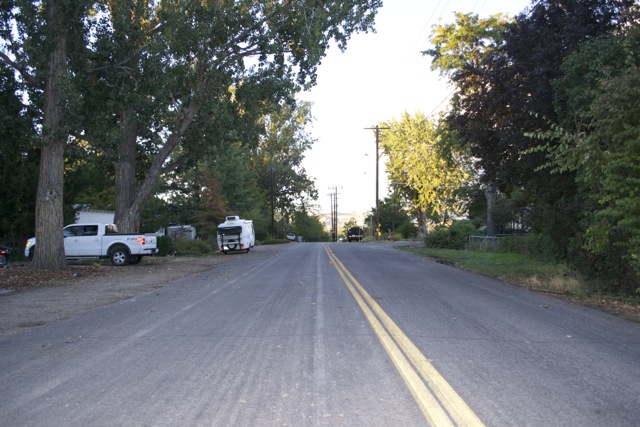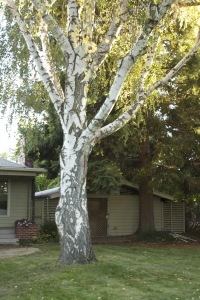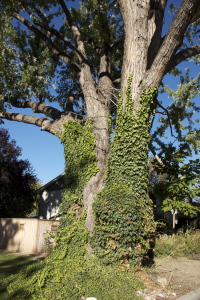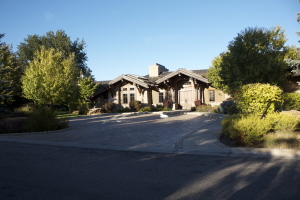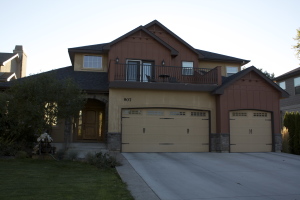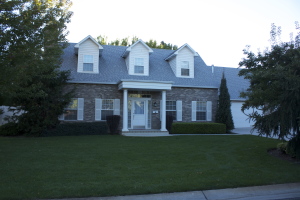Boise’s Central Rim neighborhood has roots in the late 19th century, starting with the construction of the Ridenbaugh Canal in 1878, which brought water to the desert bench above Boise City.[1] Irrigation enabled settlement, and with those people came orchards, farms, and homesteads. One important milestone for the neighborhood includes the purchase of land for Morris Hill Cemetery in 1882.[2] Another is the building of the Franklin School in 1905, which went on to become part of the Boise School District in 1945.[3] Boise City annexed the neighborhood in four segments, beginning in October 1947 and ending in December 1963.[4] Now considered centrally located, the neighborhood is alive and well, establishing itself as a part of Boise with a long and rich history.
Pat Schubert, a lifelong Central Rim resident, remembers the neighborhood being composed primarily of pasture during her childhood.[5] She recalls walking with her siblings past orchards and fields on their way to Franklin School. They spent free time at what they called the “Baby Pond,” which might have been a drainage pond but proved to be a gathering place for the neighborhood children. The Schuberts kept two cows, pigs, a garden, and fruit trees, as did most of their neighbors. This photo shows a pear growing on one of the few remaining fruit trees in the neighborhood.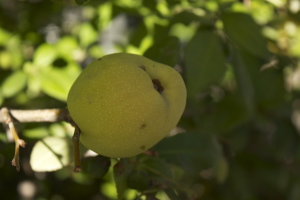 Carol Fogle, previously Carol Long, is another Central Rim native who shares a similar memory of the neighborhood. The Long family owned a variety of lots in the neighborhood over the years, many of them pastures in which they kept cows and horses. In fact, horseback riding was Carol’s main preoccupation growing up. During an interview with Carol, she stated, “I rode horses… and I could get on my horse and get to the foothills without an issue… or I could get on my horse and go out to the desert and ride that way.”[6] The empty space of the landscape, combined with the easy access to the fairgrounds and, further out, to the desert made the area feel spacious and rural in contrast to the Boise that existed just beneath them.
Carol Fogle, previously Carol Long, is another Central Rim native who shares a similar memory of the neighborhood. The Long family owned a variety of lots in the neighborhood over the years, many of them pastures in which they kept cows and horses. In fact, horseback riding was Carol’s main preoccupation growing up. During an interview with Carol, she stated, “I rode horses… and I could get on my horse and get to the foothills without an issue… or I could get on my horse and go out to the desert and ride that way.”[6] The empty space of the landscape, combined with the easy access to the fairgrounds and, further out, to the desert made the area feel spacious and rural in contrast to the Boise that existed just beneath them.
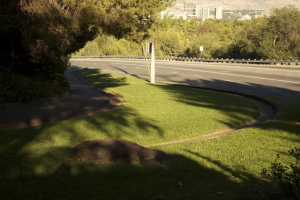
Despite these rural qualities, the railroad tracks, trolley line, and trestle that existed throughout the Central Rim gave testament to the innovation of transportation. The trolley was instrumental in connecting downtown Boise, or Boise “proper,” with other neighborhoods like the Central Rim, reaching as far as Star and Caldwell. People could take the trolley from downtown to the stop at the end of Garden Street, where they could purchase flowers from a vendor. The image to the right shows the remains of where the trolley system reached the neighborhood. Though not obvious in its appearances, it is an important piece of the landscape and the history of the Central Rim Neighborhood.
The building where the flower stand was still exists today, but now it overlooks the freeway connector instead of the trolley line. What was once twenty six acres of communally owned pasture is now Kathryn Albertson Park. You would be hard-pressed to find horses, cows, or pigs in the backyard of a Central Rim home. Over the years, the pastures and farms made way for subdivision, development, and an increased population. But traces still remain as evidence of the past: evidence of trolley tracks and railroad lines still exist in the neighborhood. Now elderly fruit trees still stand among the older homes and new developments; some have turned barren while others still produce fruit. Trees planted over eighty years ago have grown into giant and spreading oaks and elms, providing shade and standing tall as neighborhood sentinels.
The homes built amidst this landscape vary in aesthetic, age, and size. Some of the oldest houses were constructed around the turn of the century. In contrast, new homes are still being built today. One such example is on Houston Road, located on the rim that makes up the eastern border of the neighborhood. Mickey Myhre of 906 Houston Road noted that it is a common occurrence to see new, large homes being built on the street.[7]
The Myhre home, however, was built by the Otter family in 1941. Said to be the first home built on the rim that overlooks downtown Boise, John Vernon Otter chose the location for the house so that he could view the construction of Ann Morrison Park to the south. Otter was an engineer and worked on the project. Myhre described the home as cottage style. It originally housed three bedrooms, one and half baths, and was around 1,500 square feet. It did not have a garage but there was a carport, typical of the houses built during the 1940s and 1950s.[8]
When the Myhres purchased the home, they had a vision of adding onto and updating it. They promised the Otter family the original home would remain respectfully intact, and they have since created a home that beautifully connects the past with the present. “The front door is the original door,” mentioned the Myhres, as are some of the other fixtures, interior doors and wood floors. The family even kept pieces of the Otter family’s furniture, reupholstering and giving the pieces a place in their simultaneously old and new home.[9]
The above images are examples of what houses look like on Houston Road in current day. The elegance, size, and beauty of the Myhre house is a common and important thread on this street. Myhre noted that the property values on Houston Road are very high at present, so much so that some of his older neighbors are being forced to relocate to homes with lower taxes. The large and established trees that line the streets and provide the homes a sense of privacy may be a source of that value, at very least to the residents. “The trees are as important to us as the house,” said Myhre, referencing the huge white oak in his backyard.[10]
Joelle Busey also lived down the street at 1120 Houston Road, in a Cape Cod or Bench Colonial Revival style home.[11] Homes on the east side of the street, directly on the rim, have the coveted view overlooking Boise parks, the river, and downtown. The affluent of Boise may have chosen the location to be able to watch the city as it grew. Whatever the original reason, the view provided is still a primary motivation for moving to a home on the rim today.
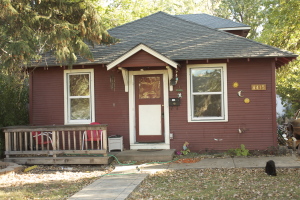
To the west, the homes grow smaller. It is this part of the neighborhood in which Barber houses can be found. The Barber homes were moved into the neighborhood after the closing of the Barber Mill in 1935.[12] They are typically small and have a box-like shape. Pat Schubert took part in the creation of the Central Rim neighborhood plan in 2004. Her focus of study was the Barber homes. Schubert identified that there are five existing Barber homes in the Central Rim. The oldest of these homes, located at 4403 Holmes Street, was built in 1900. The youngest, located at 4413 Holmes Street, was built in 1935. The smallest of the five Barber houses is 618 square feet, while the largest boasts 1960 square feet. The homes exist on Holmes, Rim, Gage, and North Garden Street. This photo is an example of a Barber house located at 4415 Holmes Street, which now includes a newer addition on the back of the original house.
Perhaps Schubert’s interest in the Barber homes stems from her grandmother, who lived in a Barber home in the neighborhood. The neighborhood certainly holds history for Schubert, as she was born there. Her father built their home on Garden Street in “his spare time,” completing the project in the 1930s. Prior to that, the family rented another home in the neighborhood. Schubert recounted that the house was “very large…but very basic.” Her father was originally from the McCall area, and he built the home with a steeply pitched roof to combat the snow he was accustomed to. Growing up, their address was only a route number. It was only after being annexed into Boise City proper that their mail was delivered to 1004 North Garden Street.[13]
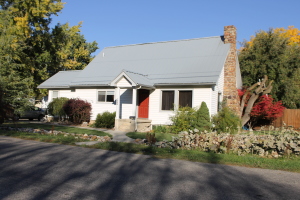
It might be easy to drive through the Central Rim and not really see the streets, houses, yards, and trees. With some extra time and consideration, a visitor can recognize the age and diversity of the neighborhood. The community has made great leaps and bounds over the years, in terms of both population and landscape. Just listen to the stories of the residents, with their own unique memories of the neighborhood and the changes that have happened. All of this combined within the Central Rim serves as an important reminder of Boise’s history. The Central Rim neighborhood has great history to be remembered as well as an important future to be formed.
Citations:
[1] Everhart, Dan. “The Bench Buildings.” Boise Architecture Project. 2014. Accessed November 5, 2014. <http://boisearchitecture.org/location.php?id=6>.
[2] Boise Parks and Recreation. “Morris Hill Cemetery.” City of Boise Idaho. 2014. Accessed November 5, 2014. <http://parks.cityofboise.org/parks-locations/parks/morris-hill-cemetery/>.
[3] Mitchell, Amaura, and Jenny Johnson. “Franklin Elementary.” Boise Architecture Project. 2014. Accessed November 5, 2014. <http://boisearchitecture.org/structuredetail.php?id=130.>.
[4] Central Rim Neighborhood Plan. (2004). 1st ed. [ebook] Boise, p.7. Available at: <http://pds.cityofboise.org/media/80688/Plan_CentralRim.pdf>. [Accessed 5 Nov. 2014].
[5] Schubert, P. (2014). Pat Schubert Interview.
[6] Fogle, C. (2014). Carol Fogle Interview.
[7] Myhre, M. (2014). Micky Myhre Interview.
[8] Myhre, M. (2014). Micky Myhre Interview.
[9] Myhre, M. (2014). Micky Myhre Interview.
[10] Myhre, M. (2014). Micky Myhre Interview.
[11] Busey, J. (2014). Joelle Busey Interview.
[12] Central Rim Neighborhood Plan. (2004). 1st ed. [ebook] Boise, Available at: <http://pds.cityofboise.org/media/80688/Plan_CentralRim.pdf>. [Accessed 5 Nov. 2014].
[13] Schubert, P. (2014). Pat Schubert Interview.
Image Citations:
Garden Street, c. 1918, Courtesy: Idaho State Historical Society, P1992-44-99
All images used on this site are copyright the Central Rim Neighborhood Project unless otherwise attributed.
Images provided on this essay were taken by Britnee Mitchell, a contributor to the Central Rim Neighborhood Project.
![[Photo] Garden Street; ISHS P1992-44-99](http://centralrim.idahohistory.org/wp-content/uploads/2014/10/Photo-Garden-Street-ISHS-P1992-44-991.jpg)
